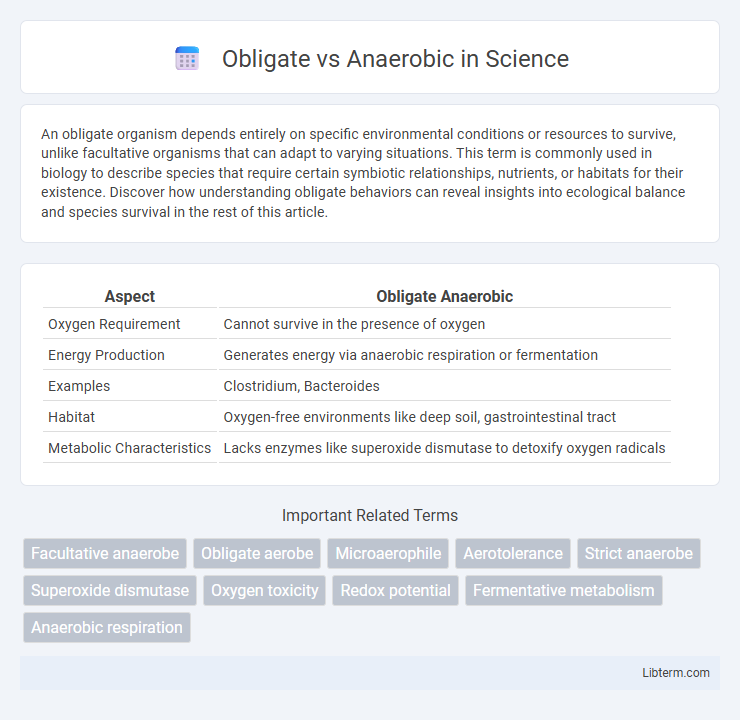An obligate organism depends entirely on specific environmental conditions or resources to survive, unlike facultative organisms that can adapt to varying situations. This term is commonly used in biology to describe species that require certain symbiotic relationships, nutrients, or habitats for their existence. Discover how understanding obligate behaviors can reveal insights into ecological balance and species survival in the rest of this article.
Table of Comparison
| Aspect | Obligate Anaerobic |
|---|---|
| Oxygen Requirement | Cannot survive in the presence of oxygen |
| Energy Production | Generates energy via anaerobic respiration or fermentation |
| Examples | Clostridium, Bacteroides |
| Habitat | Oxygen-free environments like deep soil, gastrointestinal tract |
| Metabolic Characteristics | Lacks enzymes like superoxide dismutase to detoxify oxygen radicals |
Introduction to Obligate and Anaerobic Organisms
Obligate organisms require specific environmental conditions to survive, such as obligate aerobes that need oxygen for cellular respiration, and obligate anaerobes that cannot tolerate oxygen, thriving only in oxygen-free environments. Anaerobic organisms perform metabolic processes in the absence of oxygen, using alternative electron acceptors like nitrate or sulfate for energy production. Understanding the distinctions between obligate aerobes, obligate anaerobes, and facultative anaerobes is crucial for studying microbial ecology and metabolic diversity.
Defining Obligate Aerobes
Obligate aerobes are microorganisms that require oxygen for survival and energy production through aerobic respiration. They rely exclusively on oxygen as the final electron acceptor in their metabolic processes, making oxygen essential for their growth and function. In contrast, anaerobic organisms either cannot tolerate oxygen or do not require it, using alternative metabolic pathways to generate energy in oxygen-free environments.
Characteristics of Obligate Anaerobes
Obligate anaerobes are microorganisms that cannot survive in the presence of oxygen, as it is toxic to their cellular processes. These organisms rely exclusively on anaerobic respiration or fermentation to generate energy, often producing byproducts such as hydrogen sulfide or organic acids. They are commonly found in environments devoid of oxygen, such as deep soil, sediments, and the gastrointestinal tract of animals.
Key Differences Between Obligate and Anaerobic Microbes
Obligate microbes strictly require specific conditions such as oxygen presence (obligate aerobes) or absence (obligate anaerobes) for survival, while anaerobic microbes generally thrive in oxygen-free environments but can include both obligate and facultative anaerobes. Obligate anaerobes are harmed by oxygen exposure due to the lack of protective enzymes like superoxide dismutase and catalase, whereas facultative anaerobes can switch between aerobic and anaerobic metabolism. Key biochemical distinctions involve oxygen tolerance, enzyme presence for detoxifying reactive oxygen species, and metabolic pathways adapted for energy production under varying oxygen levels.
Environmental Requirements for Growth
Obligate anaerobes thrive exclusively in environments completely devoid of oxygen, as exposure to oxygen can be lethal due to the absence of necessary enzymes to neutralize reactive oxygen species. In contrast, facultative anaerobes prefer oxygen for aerobic respiration but can survive and grow anaerobically through fermentation or anaerobic respiration when oxygen is absent. These differing environmental requirements dictate their ecological niches and influence microbial community dynamics in anaerobic habitats like deep soils, sediments, and the gastrointestinal tract.
Metabolic Pathways in Obligate vs Anaerobic Organisms
Obligate anaerobic organisms rely exclusively on anaerobic respiration or fermentation pathways for ATP production, as they lack enzymes to neutralize toxic oxygen species, rendering oxygen harmful. In contrast, facultative anaerobes possess versatile metabolic pathways that enable switching between aerobic respiration when oxygen is present and anaerobic pathways like fermentation under oxygen-deprived conditions. Obligate aerobes depend on oxidative phosphorylation in the presence of oxygen, highlighting distinct metabolic adaptations based on oxygen availability.
Ecological Roles and Habitats
Obligate anaerobes thrive in oxygen-free environments such as deep soil layers, sediments, and the gastrointestinal tracts of animals, playing crucial roles in organic matter decomposition and nutrient recycling. These microorganisms participate in processes like methanogenesis and sulfate reduction, significantly impacting carbon and sulfur cycles. Their ecological niches contrast with facultative anaerobes, which can switch between aerobic and anaerobic metabolism depending on oxygen availability, allowing adaptability in fluctuating habitats.
Clinical Significance and Pathogenicity
Obligate anaerobes require an oxygen-free environment to survive and are commonly associated with severe infections such as abscesses, necrotizing fasciitis, and bacteremia due to their ability to evade aerobic immune defenses. Obligate aerobes depend on oxygen and are often less pathogenic but can cause opportunistic infections in immunocompromised patients. Understanding the oxygen requirements of these bacteria aids in targeted antimicrobial therapy and improves clinical outcomes by guiding proper specimen collection and infection site management.
Detection and Culturing Techniques
Obligate anaerobes require strictly oxygen-free environments for growth, necessitating the use of specialized culturing techniques such as GasPak systems or anaerobic chambers that maintain anoxic conditions. Detection methods often involve culturing on media within sealed containers combined with redox indicators like resazurin to confirm the absence of oxygen. Molecular techniques like PCR targeting specific anaerobic bacterial genes complement traditional anaerobic culture by enabling rapid identification without exposure to oxygen.
Implications for Biotechnology and Medicine
Obligate anaerobes require oxygen-free environments, making them crucial in biotechnological applications like biofuel production and waste treatment where oxygen presence hinders processes. Understanding their metabolic pathways aids in developing targeted antibiotics and therapies for infections caused by anaerobic pathogens such as Clostridium difficile. Manipulating obligate anaerobic conditions enables innovations in gut microbiome research and designing probiotics that thrive in oxygen-limited niches for improved human health.
Obligate Infographic

 libterm.com
libterm.com